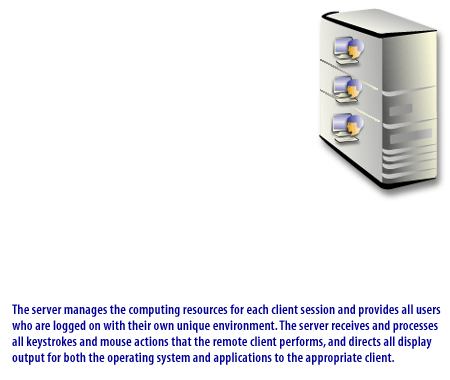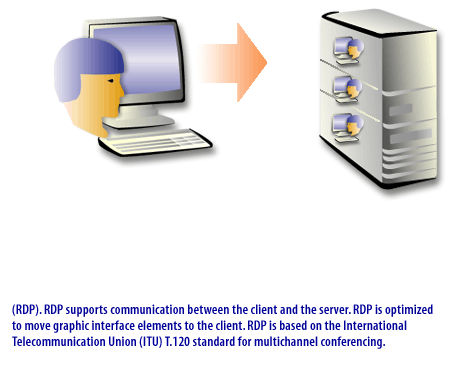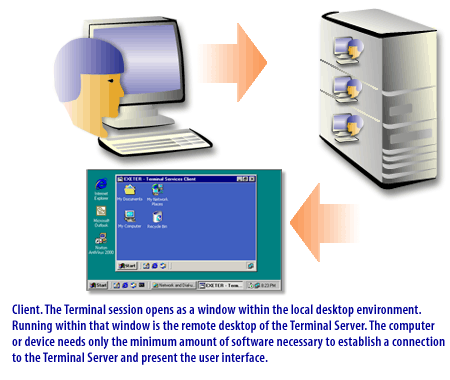| Lesson 2 | Features and benefits of Terminal Services |
| Objective | Describe features and benefits of Terminal Services. |
Features | Benefits of Terminal Services
Terminal Services enables multiuser access to the Windows 2000 operating system, allowing several people to run sessions from a single computer simultaneously. Administrators can install Windows-based applications on a server running Terminal Services. These applications are available to all clients who connect to the server desktop. Although users may have different hardware and operating systems, the terminal session that opens on the client desktop looks the same and runs the same way on each device.
Microsoft Terminal Services, now known as Remote Desktop Services (RDS), has evolved but is still an integral part of Windows Server, including the latest Windows Server 2022. The service continues to allow users to take control of a remote computer or virtual machine over a network connection. According to a recent update, Remote Desktop Services is expected to be supported at least until October 2031, which is the end of life for extended support on Server 2022. This support includes a commitment to the core RDS functionality, ensuring that it remains a viable option for on-premises deployment for the foreseeable future.
Moreover, the command-line tools related to Remote Desktop Services are detailed in Microsoft's documentation, affirming their applicability to Windows Server 2022, along with previous versions of Windows Server. This means that the foundational capabilities provided by Terminal Services, such as remote administration and application delivery, continue to be relevant and are maintained in the latest versions of Windows Server.
The following series of images describes the three parts of Terminal Services.



Benefits of Terminal Services
Many network-based applications, such as Microsoft NetMeeting, employ the ITU T.120 standard. For more information about the T.120 standard, see the International Multimedia Teleconferencing Consortium. The features of Terminal Services provide several benefits that an organization can use for a range of business purposes:
- Access to Windows 2000 desktop and applications
- Increased security and reliability
- Enhanced administration and support
- Access to Windows 2000 Desktop and Applications: Terminal Services can be used to extend the Windows 2000 operating system and Windows-based applications to a variety of clients. The following list describes some of the advantages of extending access:
- Run Windows Applications: You can make Windows-based applications available to a wide range of clients with little or no modification. You do not need to rewrite applications to run on different operating systems and hardware. Machines that run other versions of Windows, such as Windows 3.1, Windows 95, or Windows 98, can take advantage of high-end applications that run only in Windows 2000.
- Extend Use of older equipment: You can implement Terminal Services as a transitional technology to bridge older operating systems and desktop environments to Windows 2000 and 32-bit Windows-based applications. For example, if your organization cannot afford to upgrade its fleet of 486 computers, they can be refitted as Terminal Server clients and take advantage of the software and management features of Windows 2000.
- Replace text-based terminals: Because many Windows-based terminals also natively support terminal emulation on the same device, organizations can replace text-based terminals with Windows-based terminals. Windows-based terminals enable users who work with data from mainframe systems to have access to newer Windows-based applications such as email. The mainframe, text-based Terminal Session runs in a window in the Windows Terminal Session itself. Note: With the Citrix MetaFrame add-on installed, non-Windows clients can also connect to Terminal Services.
Increased Security and Reliability
Because no application or user data ever resides on the client, Terminal Services provides more control for security. Terminal Services also provides multilevel encryption support, which you can enable whenever there is a risk of unauthorized transmission interception on the link between the server and the client. There are three levels of encryption available: low, medium, and high. All levels of encryption use the standard RSA RC4 encryption. When users run sessions on the Terminal Server, their data is saved on the Terminal Server. This provides a fail-safe saving mechanism, guaranteeing that users do not inadvertently forget to save their data to the server, and then lose it because the client machines are not part of the enterprise backup routine. Because sessions are encrypted, Terminal Services can also provide an added layer of security.
Enhanced Administration and Support
Terminal Services has several features that are useful for administration and support tasks, which can also help reduce administration and support costs:
Remote administration: Administrators can manage Windows 2000 servers from a single desktop. Administrators have access to system management tools and can perform all administrative tasks, including software installation, as if they were performing them locally at the server. Shadow and remote control client sessions: Administrators can monitor the actions of a user who is logged on to a Terminal Server by shadowing the client session from another client session. Administrators or support personnel can also input keyboard and mouse actions during a client session by enabling remote control. Both shadowing and remote control can be useful for training or supporting users on new systems or applications. Note: Before you shadow a session or enable remote control of a session, you can inform the user by displaying a message on the client. The user must then give you permission to view or take part in the session.
Question: What is the primary security benefit provided by Terminal Services?
Answer: All data is saved to the Terminal Server, which supports encryption. The next lesson explores the user environment.
Remote administration: Administrators can manage Windows 2000 servers from a single desktop. Administrators have access to system management tools and can perform all administrative tasks, including software installation, as if they were performing them locally at the server. Shadow and remote control client sessions: Administrators can monitor the actions of a user who is logged on to a Terminal Server by shadowing the client session from another client session. Administrators or support personnel can also input keyboard and mouse actions during a client session by enabling remote control. Both shadowing and remote control can be useful for training or supporting users on new systems or applications. Note: Before you shadow a session or enable remote control of a session, you can inform the user by displaying a message on the client. The user must then give you permission to view or take part in the session.
Question: What is the primary security benefit provided by Terminal Services?
Answer: All data is saved to the Terminal Server, which supports encryption. The next lesson explores the user environment.